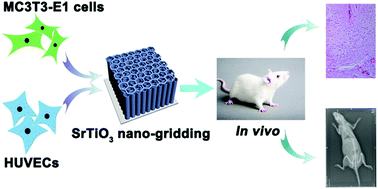Osteogenic activity and angiogenesis of a SrTiO3 nano-gridding structure on titanium surface
Abstract
Osteogenesis and angiogenesis have been considered to be the most direct and necessary requirements for Ti-based implants used in bone regeneration. In this study, an alveolate double-layered SrTiO3 nano-gridding (NG-Sr) was obtained using two steps of anodization followed by a hydrothermal process. Different Sr gradient contents (NG-Sr0.02, NG-Sr0.04, NG-Sr0.08, NG-Sr0.12 and NG-Sr0.16) were generated by altering the precursor solution concentrations. The in vitro studies indicated that NG-Sr samples with nanoscale topography and long-lasting Sr release could enhance the biofunction of both osteoblast-like cells (MC3T3-E1 cells) and human umbilical vein endothelial cells (HUVECs) to varying degrees. The NG-Sr0.08 was the optimal substrate for MC3T3-E1 cell growth, while the NG-Sr0.04 was the best choice for HUVEC growth. In vivo X-ray analysis and histological observations demonstrated that the NG-Sr0.08 samples had notable osteogenesis and angiogenesis, as significant new bone formation and fresh blood vessels were observed. Hence, the nanoscale topography with sufficient Sr supplementation offers a new independent regulator of two types of cell growth, which should be considered in biomaterial design for regenerative medicine.


 Please wait while we load your content...
Please wait while we load your content...